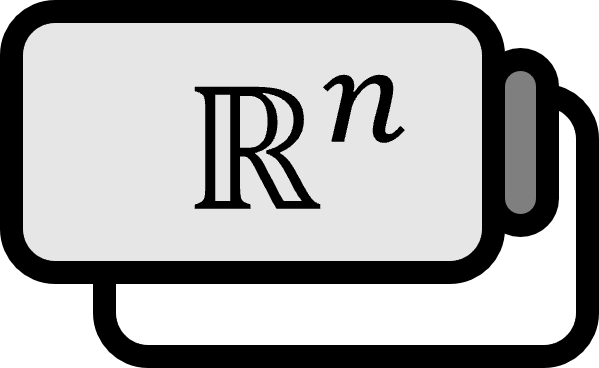Angle Between Two Vectors in an n-Dimensional Euclidean Space
Definition1
$n$Vector space of dimension n, for two vectors $\mathbf{v}, \mathbf{u} \in \mathbb{R}^{n}$, the angle between them is defined as the $\theta$ satisfying the following condition.
$$ \cos \theta = \dfrac{\mathbf{v} \cdot \mathbf{u}}{\|\mathbf{v}\| \|\mathbf{u}\|} \tag{1} $$
Here, $\cdot$ is the inner product.
Explanation
In 2D or 3D spaces, since vectors can be visualized as arrows, the concept of the “angle between two vectors” can be understood intuitively and geometrically represented. Hence, defining the inner product of two vectors $\mathbf{v} = (v_{1}, v_{2}, v_{3})$ and $\mathbf{u} = (u_{1}, u_{2}, u_{3})$ as $\mathbf{v} \cdot \mathbf{u} = v_{1}u_{1} + v_{2}u_{2} + v_{3}u_{3}$ allowed us to demonstrate theorem that the following equation holds using the law of cosines.
$$ \mathbf{v} \cdot \mathbf{u} = \|\mathbf{v}\| \|\mathbf{u}\| \cos \theta \tag{2} $$
However, in vector spaces of dimension $4$ or higher, it is impossible to visualize and geometrically represent vectors in a way that is easily understood. Therefore, even talking about the angle between two vectors becomes a challenge. In $n(\ge 4)$-dimensional vector space, the angle between two vectors is defined using $(2)$. That is, in dimensions greater than or equal to $4$, $(2)$ is not proved as a theorem, but is taken as the definition itself. This allows $(2)$ to hold not only in 2D and 3D but in any dimension, making it a natural generalization.
Well-Definedness
Rewriting $(1)$, we have:
$$ \theta := \cos^{-1} \left( \dfrac{\mathbf{v} \cdot \mathbf{u}}{\|\mathbf{v}\| \|\mathbf{u}\|} \right) $$
As is known, the inverse cosine function must be carefully considered regarding its domain and range. The domain and range of $\cos^{-1}$ are as follows:
$$ \cos^{-1} : [-1, 1] \to [0, \pi] $$
Thus, for all $\mathbf{v}, \mathbf{u}$, $\set{ \mathbf{v} \cdot \mathbf{u} / \|\mathbf{v}\| \|\mathbf{u}\| } \subset [-1, 1]$ must hold, and indeed this is ensured by the Cauchy-Schwarz inequality.
$$ |\mathbf{v} \cdot \mathbf{u}| \le \|\mathbf{v}\| \|\mathbf{u}\| \implies \dfrac{| \mathbf{v} \cdot \mathbf{u} |}{\|\mathbf{v}\| \|\mathbf{u}\|} \le 1 \implies -1 \le \dfrac{ \mathbf{v} \cdot \mathbf{u} }{\|\mathbf{v}\| \|\mathbf{u}\|} \le 1 $$
In summary, we see that $(1)$ is well-defined.
Orthogonality
Having defined the angle between two vectors, we can now discuss orthogonality. Vectors $\mathbf{v}, \mathbf{u} \in \mathbb{R}^{n}$ in $n$-dimensional space are said to be orthogonal if the following condition holds.
$$ \mathbf{v} \cdot \mathbf{u} = 0 $$
Again, in an $3$-dimensional space, this can be shown to hold as a theorem, but in $n(\ge 4)$-dimensional spaces, it is taken as a definition.
For reference, the term perpendicular is more intuitive and geometric, mainly used to describe situations forming right angles in 2D or 3D spaces. In contrast, orthogonal gives a more abstract sense, commonly used in $n$-dimensional or infinite-dimensional vector spaces.
Howard Anton, Elementary Linear Algebra: Aplications Version (12th Edition, 2019), p352-353 ↩︎
